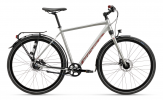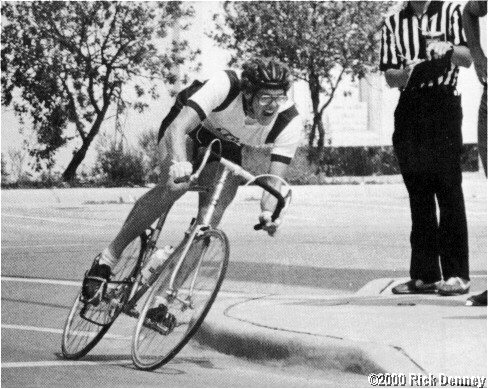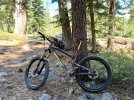Hmmm. More aero wheels, yes indeed. But lighter? I wrote an article on that topic in
Triathlete back in the late 90's, performing some analytics using Tom Compton's web site (now, sadly, gone). Here's my copy on my web page:
https://www.rickdenney.com/october_1999.htm.
It takes a lot of weight difference to make a significant difference, as it turns out--more than we think. But light weight sells parts (that break or are wiggly). My MX-Leader is 22 or 23 pounds built up with Campy Chorus, and they were described in the day as the bike the (bigger) pros didn't want to ride up the mountains, but the one they were glad they had coming back down the mountains.
The use of the non-horizontal top tube is a weight-savings measure, but we dang near have to add all that weight back into the seatpost that now has to support our fat butts with a foot and a half showing above the seatpost clamp.
But aero wheels? Yes--that makes a more significant difference for those who do triathlon or time trials. For non-racers, I doubt it matters a whit. Those 32- or 36-spoke shallow-section rims sure were
light. 
Failproof derailleurs? Hmmmm. Certainly the cheap stuff is better. But once in a while I go for a ride on the Moore, and remind myself that those downtube friction shifters (which are light and foolproof) just work, and work actually really well. Sure, I prefer shifting with my hands on the brake lever hoods, particularly if I'm climbing out of the saddle. But I don't confuse convenience of operation with "smooth" and "failproof". In fact, if a Shimano brake-lever-shifter breaks, it's probably time for the trash can. (The Campy Ergo levers of old--which I prefer--seem a little easier to bring back, but that's anecdotal on my part.) I have Gripshift on my MTB, and have had to rebuild it once, despite fairly low (though painful) miles. I have no experience with SRAM, but I hear good things about it. But I've never met a Campy Nuovo Record derailleur I couldn't make perfect, barring crash damage, and the Sun Tour Cyclone of the late 70's totally obsoleted all the prior inexpensive derailleur designs for smooth operation.
Geometry more ergonomic? Only if you like leaning over more. The geometry of race bikes seeks a flatter back than in days of yore (see above about aerodynamics being more important than weight). That's good for efficiency, but hard on the wrists and elbows (and back, and neck). That's why people invented elbow rests, which morphed into tri-bars. Also, as I can attest, after swimming 2.4 miles, the ability to hold up one's upper body with those trashed arms is at a low state. Greg Lemond first used them in the Tour de France and changed pro cycling (in time trials) forever.
Personally, I'm of the mind that older bikes with a longer wheelbase and slacker angles are actually better for just about everything (okay, not track sprints, and--maybe--not criteriums).
One place where technology has improved is in stiffness optimization. We want a bit of fork flex up and down, and we want a long wheelbase to minimize vertical accelerations caused by a given surface profile. The problem with those long chain stays is that they twist easily. The truss design of a double-diamond frame deflects so little under even impact that it hardly makes any difference, but when we clydesdales stand up on those pedals, or when the guys with 30" thighs jump on a sprint, the bottom bracket will wind up torsionally. On a lightweight steel frame, I can make the front derailleur drag on both sides of the cage. On early aluminum bicycles like the wet-noodle Alan of 45 years ago, I can make it shift gears. That's with conventional tubing sets. The Columbus MXL tubing on the MX-Leader includes enormously stiff chain stays--they are the full height of the bottom-bracket shell where they connect to it. That makes all the difference in torsional stiffness, without giving up a bit of comfort. Those specially and asymmetrically shaped tubing sets were indeed a significant improvement, no matter what the material. Carbon bikes can target stiffness right where they want to, and do it with remarkable weight efficiency. Carbon composites that are affordable is another big advance, but not because they are light so much as they are stiff in the right directions and compliant otherwise.
Back when we were buying race bikes in the 70's, we used tall frames, short seatposts, long stems pushed down all the way, and handlebars with deep drops. (My favorites where Cinelli Model 66's.) Racing was done in the drops for the most part.
My old A&M Cycling Team mate John Simmons, a great college road sprinter back before colleges even really had official teams, showing the usual racing position while taking a flyer at a race in 1979:
Now, we have shorter frames, longer seatposts (and longer still if the frame has a sloping top tube), "ergo" bars designed for the drops only on special occasions, and brifters. Better? Yes, for getting more aero, and for selling more high-end bikes. John has to be in the drops to get a flat back. Now, you'll see a flat back on the tops (bent elbows, of course).
And aero wheels--yup. That's a big'un.
Rick "figuring his Spinergy HD's saved him 5-6 minutes at the Ironman" Denney



